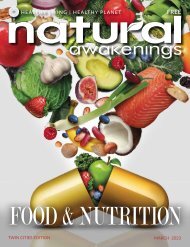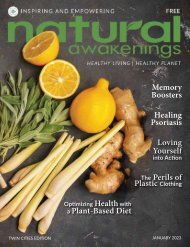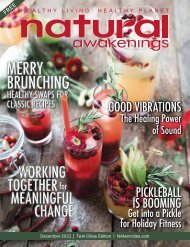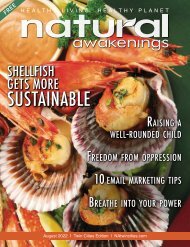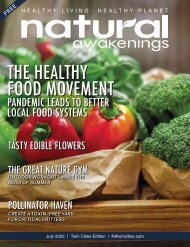Natural Awakenings Twin Cities February 2022
Read the February 2022 edition of Natural Awakenings Twin Cities magazine. This is our annual Heart-Centered Living Issue which is focused on minding the heart and heart and mind connection. This month we feature articles on living on the frequency of love, truly making love, sound of your heart determines your health, fermenting for foodies, parents as role models and so much more! Be sure to check out our local content including News Briefs announcements, Community Resource Guide with providers throughout the metro who can meet your individual wellness needs, and all the happenings in the Calendar of Events. There is additional online-only content that can be found at NATwinCities.com. While you are there, be sure to sign up for our Newsletter and Digital Magazine and continue your reading with our archived articles from local experts.
Read the February 2022 edition of Natural Awakenings Twin Cities magazine. This is our annual Heart-Centered Living Issue which is focused on minding the heart and heart and mind connection. This month we feature articles on living on the frequency of love, truly making love, sound of your heart determines your health, fermenting for foodies, parents as role models and so much more!
Be sure to check out our local content including News Briefs announcements, Community Resource Guide with providers throughout the metro who can meet your individual wellness needs, and all the happenings in the Calendar of Events. There is additional online-only content that can be found at NATwinCities.com.
While you are there, be sure to sign up for our Newsletter and Digital Magazine and continue your reading with our archived articles from local experts.
You also want an ePaper? Increase the reach of your titles
YUMPU automatically turns print PDFs into web optimized ePapers that Google loves.
culinary territory, like fermented and aged vegan cheeses from<br />
acorns and “seaweed” made from fermented broadleaf plantain,<br />
a common weed, using methods he’s studied and perfected. “I<br />
investigate new and lost flavors, and conserve them as gourmet<br />
foods through preservation,” he says.<br />
Fermentation with Benefits<br />
Fermentation transforms the nutrients in food in several ways,<br />
Katz explains. In a process known as predigestion, it breaks<br />
macronutrients down into more digestible forms (think proteins<br />
turned into amino acids) and renders minerals more bioavailable.<br />
Gluten, too, is broken down by fermentation, he says,<br />
as are potentially toxic compounds in foods such as cyanide<br />
and oxalic acid. The process also releases vitamins B and K and<br />
other micronutrients as metabolic byproducts.<br />
Fermentation reduces the short-chain carbohydrates that are<br />
poorly absorbed in the small intestine and are prone to absorb<br />
water and ferment in the colon, causing gas and bloating.<br />
Found in wheat, beans and other foods, they can pose digestive<br />
problems for people with irritable bowel syndrome and other<br />
conditions, says Tayler Silfverduk, a registered dietitian nutritionist<br />
in Columbus, Ohio, specializing in celiac disease.<br />
“The most profound nutritional benefit of fermentation is<br />
the live bacteria itself. You are ingesting a rich biodiversity of<br />
beneficial bacteria that can potentially improve immune function,”<br />
says Katz, an AIDS survivor who considers fermentation<br />
an important part of his healing process.<br />
No Starter Required<br />
“There is nothing you can eat that can’t be fermented, but the<br />
easiest and safest place to begin is with vegetables,” which<br />
need no special equipment or a starter like sourdough, kefir or<br />
kombucha, says Katz. To make sauerkraut, for example, simply<br />
shred cabbage, lightly salt and season it, and submerge it in a jar<br />
under its own juices, “burping” it daily for a week to 10 days to<br />
release the fermentation gases.<br />
Katz and Baudar both like to debunk myths that fermenting<br />
foods is difficult or dangerous. “You don’t have to sterilize everything<br />
or have precise laboratory control conditions. People<br />
have been practicing fermentation for years, and they began<br />
before they knew bacteria was a thing. To the contrary, fermentation<br />
is a strategy for food safety,” says Katz.<br />
While yeast or mold can grow on the top layer that is exposed<br />
to oxygen, Katz says “a lot of sauerkraut is needlessly discarded.<br />
Most such growth is harmless and normal, and can be skimmed<br />
off the top.”<br />
Baudar, a University of California Master Food Preserver, has<br />
kept foods he’s fermented for up to three years and only once<br />
encountered mold. “You need to work with the ferment,” he says.<br />
“That means regularly burping it, then shaking or stirring to promote<br />
the acidity that prevents bad bacteria from taking hold.”<br />
“If it looks or tastes bad, throw it away,” he adds. “Some of my<br />
early experiments tasted horrible, but I just took my failures as<br />
learning and kept experimenting. The more you understand the<br />
fermentation process, the more you can play with it creatively<br />
and push the envelope.”<br />
Connect with Washington, D.C., freelance writer April Thompson<br />
at AprilWrites.com.<br />
Fermented Pickled<br />
Carrot Sticks<br />
YIELD: 1 QUART-SIZE JAR OF PICKLES<br />
2 sprigs fresh dill<br />
1-2 cloves garlic<br />
2 lb whole carrots<br />
1 Tbsp sea salt<br />
1-2 cups distilled water<br />
Wash and peel the skins of the whole<br />
carrots. Cut the peeled and washed<br />
carrots into carrot sticks. Peel and<br />
finely slice the garlic cloves. Wash<br />
and dry 2 sprigs of dill.<br />
In a wide-mouth, quart-size jar,<br />
pack in the carrot sticks. (Tilt the jar<br />
to locate more places to squeeze in<br />
the sticks.) Add in the sea salt, then<br />
the sliced garlic and sprigs of dill.<br />
Cover the ingredients with distilled water (Be sure to leave<br />
about an inch of free space from the waterline to the opening of<br />
the jar.)<br />
Place an airtight lid on the jar and let it sit for a week or until<br />
the carrots have reached desired taste. Make sure to burp the<br />
jar at least every two days while fermenting.<br />
Once the carrot sticks have reached their desired taste, place<br />
the jar in the fridge for storage. Enjoy.<br />
Notes: If using organic carrots, leave<br />
the skin on and just wash the carrots<br />
very well before chopping into<br />
snacking sticks.<br />
When burping the jar, use<br />
this time to check on fermentation<br />
to make sure it’s<br />
growing healthy. Look for<br />
bubbles on top of the water<br />
and along the water line. Seeing<br />
mold is a sign that good bacteria<br />
is struggling to start a culture and<br />
we may need to try again.<br />
Courtesy of Tayler Silfverduk,<br />
registered dietitian nutritionist.<br />
<strong>February</strong> <strong>2022</strong><br />
23<br />
photo provided by Tayler Silfverduk RDN<br />
nataliya vaitkevich/Pexels.com









